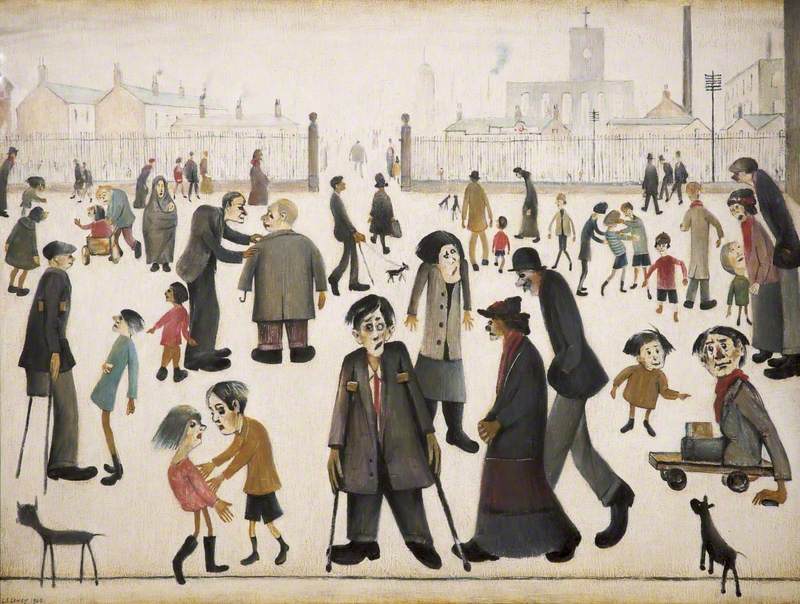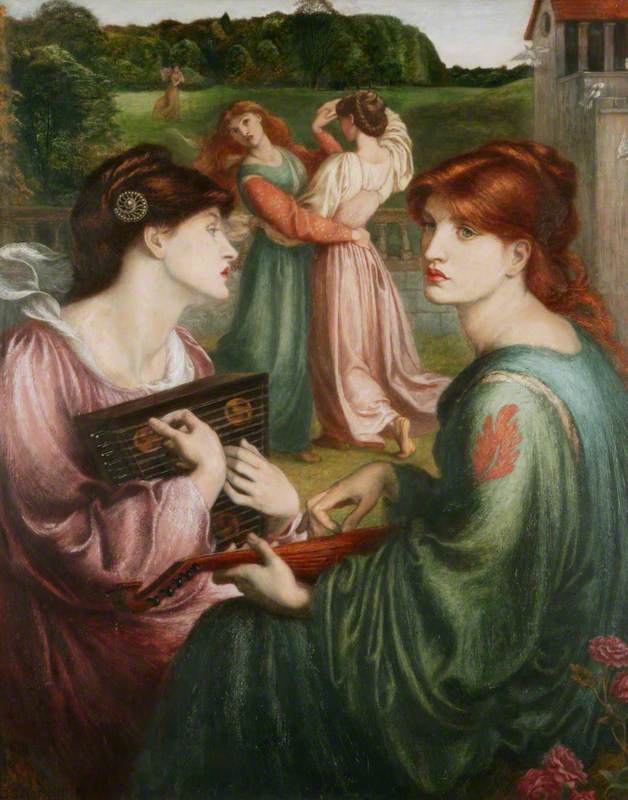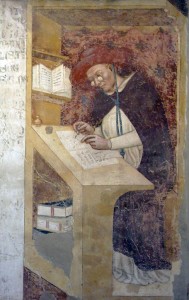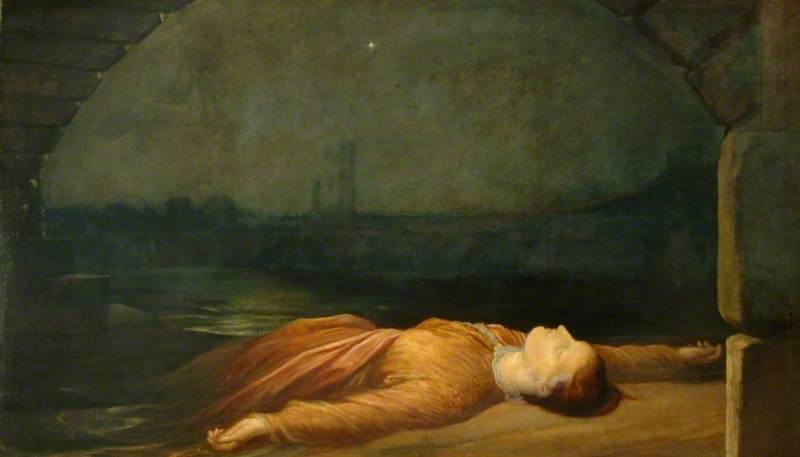The Cripples by Manchester-born artist Laurence Stephen Lowry (1887–1976) is a work steeped in controversy.
Some of this controversy relates to the title and some is specifically concerned with disability, and how Lowry represents disability within the painting.
Many consider the painting to be offensive. For instance, British art historian T. J. Clark describes it as an example of 'Lowry's interest in registering human categories or types as "a set of symptoms and specimens observed in the field".'
As a Marxist art historian, Clark is interested in representations of society and the working classes. He may not be referring here specifically to ableism – broadly defined as discrimination and social prejudice against people with disabilities – but it is certainly the case that disability is not typically considered in visual art. Ableism is found in the visual arts, for example in how disabled people are represented, and more often than not, in how they fail to be represented at all. It is arguably offensive and dehumanising to depict the disabled people in the painting as 'specimens' of a type rather than as ordinary people.
The name of the painting itself nowadays can cause offence, as 'cripple' – a term used as early as the mid-thirteenth century to describe disabled people, and commonly in use in 1949 when the painting was executed – has been considered largely a pejorative term in recent decades. While currently being reclaimed in the noun form by some in the disability community, it is still a taboo term overall – when not reclaimed by disabled people, it remains a derogatory term that devalues disabled people.
The painting's offensive nature and name should not be ignored, but given the fact that so few other portrayals of disability exist in painting, the work should be examined for what it could potentially convey beyond its ableist nature. There are relatively few examples of disability in British art, particularly where disability sits at the centre of the painting, and perhaps even within the painter.
A 2008 article in the Irish Journal of Medical Science suggested that Lowry himself might have had Asperger's syndrome, but, more importantly, Lowry also talked of disabled people being 'real people, sad people' and that he 'feels like them'. Lowry did indeed have compassion for the plight of the working classes and the disadvantaged and his paintings gave representation to this community, a community that was usually ignored and neglected. He portrayed the deprivation brought about by industrialisation and demonstrated a clear preoccupation with the lack of health and social care offered to the working classes.
However, in regards to the disabled community, this compassion is misplaced. For instance, the idea of disabled people being 'sad' cannot be ignored since it is not true – disabled people don't live inherently sad lives, full of pity. In fact, they can live full, rich lives in a society that often doesn't wish to acknowledge this, typically due to ignorance. But what if this ignorance is something that can be interpreted within the painting itself?
On the surface, the painting appears to simply show disabled people to be 'sad people'. But what if they are 'sad' not because disability is negative or to be pitied, but because of the sadness felt by disabled people because of inequality, ableism and negative treatment? On Lowry's painted street the disabled people are passively ignored among the crowd, and only acknowledged with any positivity – curiously – by children.
Lowry's 'sadness' could potentially come from the absence of support and social care that might have improved the quality of life of the disabled people he paints. By also showing them being gawked at by adults when they are noticed, the work also suggests, through its muted colour palette, that it is this treatment of disability and disabled people – and not the disability itself – that is negative, and is the reality that needs to be considered by those that view the painting.
The Cripples is an example of one of #LSLowry's composite images - collecting together a cross section of the most afflicted characters that he often saw around Manchester in the wake of the War.
— The Lowry (@The_Lowry) June 20, 2018
(LS Lowry The Cripples 1949 © The Lowry Collection, Salford) pic.twitter.com/iR2c2rhNPg
It is also vital to remember that Lowry, as the creator of the work, cannot ever be entirely separated from it, and that includes responsibility for causing distress to some viewers. However, it is up to the viewer to find a message in the work, whether it was the one Lowry intended or not.
One message that can possibly be found is arguably more hopeful than Lowry might have envisaged – that The Cripples foregrounds disabled people and the ableism they go through, rather than sidelines them as the crowd does in the painting itself.
Of course, to suggest that the work is offensive is just one interpretation. But given a relative lack of other more positive portrayals of disability in British art, there is sometimes no option but to try and find a more hopeful idea in an artwork than what was originally intended. Just as Roland Barthes conceived the idea of the 'death of the author' – the idea that the meaning of works should only be decided by the reader, and, by extension, that the author's intended meaning shouldn't matter – so perhaps we can also talk about the 'death of the painter'. The idea of a positive interpretation of a work that is ableist brings a sense of hope in itself: that harmful work can be transformed into something better while we wait for more uplifting representations to be created.
It is important to take into account that the work does harm, and not to forget that – and it is just as important for a similar space to readily be taken up by a work that conveys the same idea and interpretation more positively, and with greater authenticity. This means work that is created by a disabled artist, conveying what they wish to convey, including their own experience and thoughts on disability, and authentically representing disability in this way. I for one can't wait to experience more visual art by disabled artists, particularly art that is about disability.
This is only one interpretation made by a disabled person, who may have perhaps seen something where there isn't anything at all. But it's one made by a person who rarely sees disability portrayed in traditional art such as painting – a rare example is Mexican painter Frida Kahlo's wonderful self-portraits, such as Self-Portrait with the Portrait of Doctor Farill.
Whether you agree with the interpretation or not, it certainly suggests that we need more portrayals of disability in art, such as Kahlo's, so that we have the breadth of work to find different messages and interpretations that are actually and authentically intended, particularly by disabled artists.
The question remains: should the title The Cripples be reviewed and changed in today's context? Or should it stay and be contextualised to signify that the work – despite the positive message that may be interpreted – remains offensive? That's up for debate too.
Chloe Smith, freelance writer
Further reading
Victoria Ann Lewis, 'Crip' in Keywords for Disability Studies, NYU Press, pp.46–48
Reginald Nettles and Rochelle Balter (eds.), Multiple Minority Identities: Applications for Practice, Research, and Training, 2012
Colin Martin, 'Art with a Social Conscience' in The Lancet, vol. 382, no. 9895, p.849, 7th September 2013
H. O'Connell and M. Fitzgeral, 'Laurence Stephen Lowry and Asperger's syndrome' in Irish Journal of Medical Science, vol. 172, no. 3, 2008
Manoj Ramachandran and Jeffrey K. Aronson, 'The diagnosis of art: Lowry's Cripples' in Journal of the Royal Society of Medicine, 100 (3), pp.153–154, 2007
























